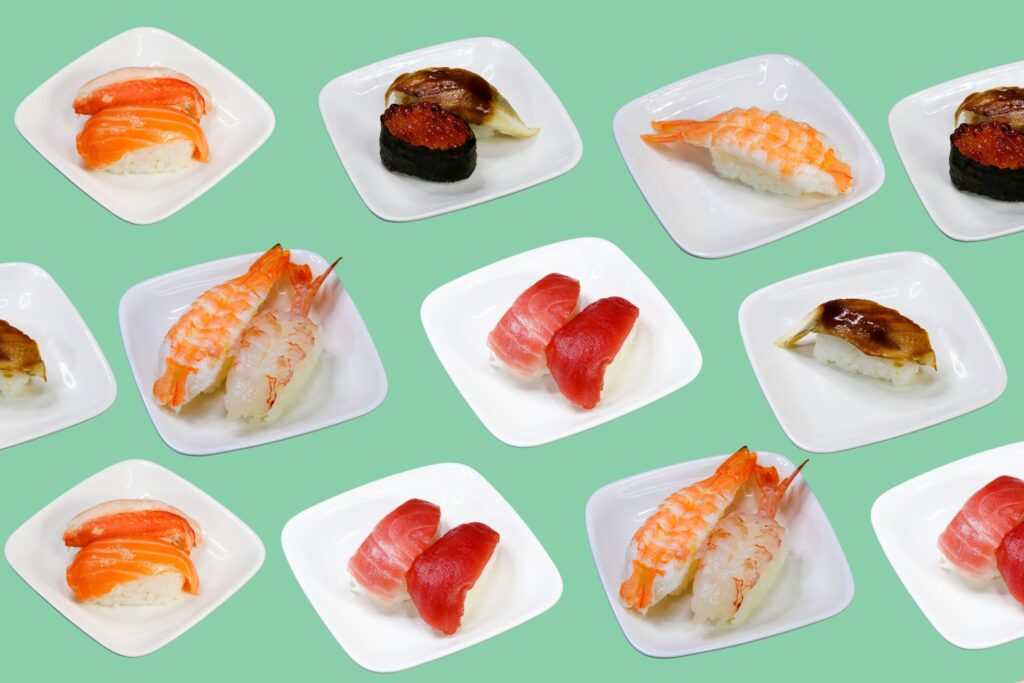Here at IDEAL we’re big fans of kaiten-zushi restaurants. Otherwise known as ‘conveyor belt’ sushi restaurants, they offer a casual, interactive dining experience and a wide variety of sushi to choose from, all at a relatively affordable price.
If you’ve never been to one before, the concept is simple – rather than sitting at a table and ordering your sushi from a menu, you get to pick out small plates that look good to you from a conveyor belt, which carries them slowly past your perch.
But with so much choice and thousands of years of tradition behind this Japanese staple, it can be difficult to know where to start, let alone how to navigate the ‘unspoken’ rules of actually eating the stuff. With International Sushi Day approaching on June 18th and with the help of Founder of Japanese food subscription company Sakuraco Ayumi Chikamoto, here’s how to eat like a pro at a sushi bar this International Sushi Day.
Know Your Type
“It can be helpful to have an idea of the different types of sushi before you visit, so you know which you might like to try first”, Chikamoto tells us.
But with so much variety, how do you know where to start? Well, its’ a good idea to know the most common types of sushi usually found at a kaiten-zushi, which include…
Nigiri: Nigiri sushi is a type of sushi made of thin slices of raw fish or other seafood placed on top of pressed vinegared rice. The fish is usually served raw, but it can be cooked or marinated, depending on the type of fish and the sushi chef’s style. Some common varieties include shrimp, tuna, salmon, and eel. Occasionally, a small amount of wasabi or a thin strip of seaweed, usually nori, may be used to bind the topping to the rice.
Maki: Also known as rolled sushi, Maki is perhaps the most recognized form of sushi, especially for those new to this Japanese cuisine. Maki sushi is made by rolling sushi rice and various ingredients within a sheet of nori using a bamboo mat. The roll is then cut into bite-sized pieces. There are different types of Maki, including Hosomaki (thin roll), Chumaki (medium roll), and Futomaki (thick roll), differing in terms of size and the amount of fillings.
Uramaki: Uramaki is essentially a reverse Maki roll, also famously known as an ‘inside-out roll’. The sushi rice is on the outside of the nori, which holds the ingredients in the centre. Uramaki often has multiple fillings, which can include diverse yet complementary ingredients like cucumber, avocado, crabmeat, or tuna. The outer layer of the roll can also be coated with other ingredients like toasted sesame seeds or fish roe for an additional layer of flavour and texture. The California Roll is a popular example of Uramaki sushi.
Temaki: Often referred to as ‘hand roll’ sushi, Temaki sushi is a cone-shaped piece made from a nori sheet filled with sushi rice, seafood, and vegetables. It’s designed to be eaten with hands rather than chopsticks. The cone allows for a variety of fillings, and the format offers a good mix of textures and flavours. Because Temaki cannot be made ahead of time without losing its crispness, it’s often prepared directly by the chef and handed to the customer immediately.

Stay Fresh
“Fresh ingredients should be your number one priority when selecting a sushi restaurant”, says Chikamoto. “Luckily, there are a few simple tricks and tips that can help you spot better dishes”, he divulges.
Contrary to popular belief, sushi shouldn’t smell fishy. In fact, according to world-renowned sushi chef Hidekazu Tojo, a good sushi restaurant should smell like cucumber or watermelon.
It’s been revealed that some establishments chill fish at the lowest possible temperatures if they think it is coming to the end of its shelf-life. If your sushi feels abnormally cold when it arrives, allow it to sit at room temperature for a couple of minutes. If it’s not fresh, it will begin to smell.
It’s worth noting that freshness shouldn’t be a huge concern, as many modern kaiten-zushi restaurants now use RFID tags to monitor how long plates stay out on the conveyor belt and take away any items that are no longer fresh.
Read: Ideal for sushi lovers: Chilli, lime & ginger sushi bowls

Quality Over Quantity
While eating seemingly infinite sushi may feel impossible to resist, the enjoyment and satisfaction derived from consuming a few pieces of high-quality sushi can be much greater.
“All the plates that pass by on the conveyor belt are color-coded according to price. Sometimes, it can be better to go for the pricier plates, this is because of the ingredients. You’ll normally find the higher the ratio of rice to filling, the less expensive the sushi will be. And then, of course, some vegetables and garnishes are inevitably more expensive than others”, explains Chikamoto.
One Bite Wonder
“Traditionally, it’s believed sushi should be enjoyed in one bite” explains Chikamoto. This is the way it is eaten in Japan. Taking a bite of a piece of sushi can break the balance of flavours and textures that the chef aimed to create. Also, it can be messy because sushi is typically not designed to be bitten in half – you might find rice spilling everywhere.
However, it’s important to consider comfort and personal preference. If the sushi piece is too large for you to comfortably eat in one bite, then it’s of course okay to eat it in two bites.
Tongue Down
There is a specific way to take that one bite – “when eating sushi, you should place it on your tongue face down, so you get the full flavor and freshness of the fish.”
The fish used in sushi is typically high quality and has subtle flavours that can be missed if the rice hits your tongue first, with the rice interfering with the taste of the fish.
In the case of nigiri sushi (a slice of fish over pressed vinegared rice), the fish is often brushed with a bit of soy sauce or other toppings. Placing it fish-side down on the tongue ensures that you taste these seasonings directly. In addition, the temperature of the fish is often cooler than the room temperature rice, and placing it directly on your tongue can heighten the experience of the flavour.
To Chopstick Or Not To Chopstick?
That is the question. Believe it or not, it’s not a faux pas to use your fingers to eat sushi, especially sashimi. It is perfectly acceptable to eat sushi with your hands. Only sashimi is meant to be eaten with chopsticks. However, ultimately, it once again comes down to personal preference.
It should be noted, however, that you should never leave chopsticks sticking upright in your bowl, as it is considered disrespectful. When not in use, place them horizontally on a chopstick rest or the edge of your plate.

Pairing & Condiments
Traditional sushi etiquette encourages minimal use of soy sauce and wasabi. Avoid mixing wasabi into your soy sauce— if the chef thinks the sushi needs wasabi, they will put the right amount on it. Dipping your sushi in too much soy sauce can overpower the delicate flavors of the fish.
“The traditional condiments that come with sushi also serve a specific purpose. Soy sauce is for dipping, ginger is for eating between different plates to cleanse your palette, and wasabi is for adding spiciness.” Yes, pickled ginger is meant to cleanse your palate between different types of sushi. It’s not intended to be eaten with the sushi itself.
Oh, and sushi should also be dipped fish-side down. If you dip the rice into the soy sauce, it can cause the rice to fall apart. Generally speaking, dipping your sushi fish-side down allows you to get the right amount of soy sauce without over-saturating the sushi or having too much soak into the rice.
When it comes to drinks, traditional etiquette suggests not to drink sake while eating rice-based sushi (as sake is made from rice), and instead opt for a beer or tea. However, these rules are more flexible these days.
Eat In Order
In terms of the order in which to drink sushi (if you’re not being served items one-by-one), it’s a good idea to start with lighter, more subtle flavours before moving on to heavier, fattier varieties. This allows the palate to appreciate each type without being overwhelmed.
“While there are no set rules on the order you eat your sushi in, some say that it’s best to start with light fish like snapper, and then move on to dark fish (salmon). This is because the lighter fish is less oily and won’t coat your tongue in fat, so you can enjoy the full taste of all your chosen dishes”, explains Chikamoto
In any case, Chikamoto recommends eating pickled ginger or taking a sip of tea to cleanse your palette between different plates.
The Bottom Line
Hopefully these tips will help deepen your appreciation and understanding of sushi as a culinary art form. No matter how you eat your sushi, ultimately, what’s most important is enjoying your meal. Now, here’s 10 ideal benefits of eating sushi. As if you needed an excuse, hey?





